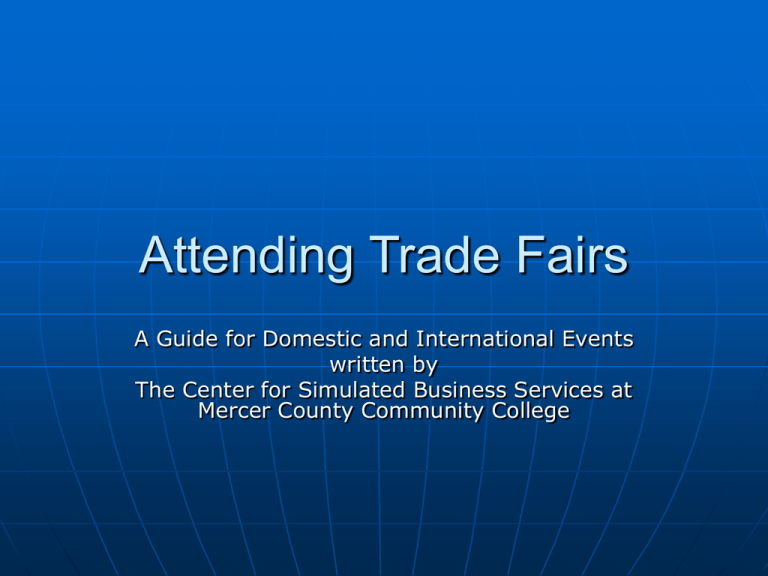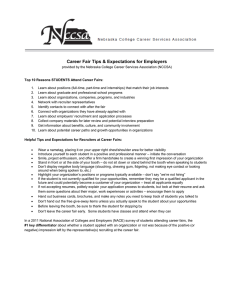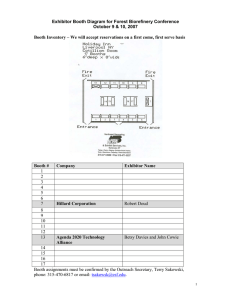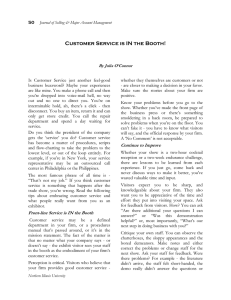Attending Trade Fairs
advertisement

Attending Trade Fairs A Guide for Domestic and International Events written by The Center for Simulated Business Services at Mercer County Community College What Are Practice Firm Trade Fairs? A marketing/sales event Event sponsored by a specific country Real events where firms buy and sell simulated products and services Real people, at a real location Who Can Attend a Trade Fair? A firm that holds membership in a recognized central office either within the U.S. or Internationally Maintains membership in EUROPEN (the worldwide association of practice firms) through its central office membership The general public—(visitors) can attend the trade fair Why Attend a Trade Fair? Access to potential customers • New opportunities • Potential buyers come to you Three-Dimensional Selling • Show actual product One-stop Shopping • A temporary shopping mall • Presence of competitors encourages the buying process Testing New Products • Provides “reading” on the marketability of a new product Competitive Boost • Small businesses have an “edge”—the personal touch Trade Fair Planning What are the specific objectives of the trade fair? Are you introducing a new product or service? Are you “shinning up” the firm image? If so, what image? Do you want to meet new customers? Are you interested in direct sales? Do you want to build a mailing list? Can your success in achieving these goals be measured? Who is your target market? Trade Fair Planning Set goals and objectives Budget planning (real dollars) • • • • • trade fair registration/booth travel costs “give aways” booth decoration/supplies clothes of staff attending (uniform shirt, tie, etc.) Target market identification Choosing display products Advertising and promotion plans Coordination of company personnel Determination of show staff and size Staff responsibilities and schedule Follow up Forecasting Sales Actual sales (dollars and quantity) Average sales per customer Sales to existing customers Sales to new customers Sales per product/service Sales over a period of time following the trade fair Preparing the Staff Review the objectives of your participation Familiarize everyone with products/services, price, tax issues, delivery, and payment Learn some basic salesmanship skills Make a set schedule for the “booth” representatives as well as the “walk the floor” representatives Schedule lunch for all participants Make assignments for booth set up—who will do what? Make assignments for booth break down Make assignments for follow up Pre Trade Fair Preparation— Beyond the Booth . . . Contact firms that you believe will be attending the fair Send out email and snail mail fliers Put something up on your website Give a “free something” for responding to you before the trade fair Special Considerations in the “Simulated” IBPF World Who will be purchasing? • Employees of the other firms as “consumers” • The other firms as “business-tobusiness” • The public—visitors, teachers, etc. who will attend the fair How will everyone pay? Practice firms will use their electronic bank account to pay. Make sure you have the account number and bank affiliation. Students of the firms will use their personal bank accounts. Make sure each firm attendee has bank number, balance, and bank affiliation with them at the fair. Guests and visitors to the fair will have “checks.” You should consider these sales as cash, and assume they are carrying the product/service with them. There will be no need to invoice them later. Note: You may begin to see the use of credit cards very soon at trade fairs. How Do We Keep Track Organization is the key . . . • Every sale and how the customer pays must be tracked • Get complete contact information from the buyer, i.e., Their firm Bank account and bank affiliation or check number (guest/visitor) Email address, fax number, telephone number Create a form to gather all of this information • Give each customer some type of receipt and maintain a copy for the firm’s records • Keep receipts for every purchase your firm makes as well as for every purchase your employees make—you will receive invoices later—so you need to keep track of what you bought. What Do We Do with the Checks? Record them accurately with each sale, i.e., check number and sale/order number Complete a deposit slip (provided by the fair organizers) and deposit in the fair bank before leaving Remember these are “cash and carry” orders The deposit will be made to your company bank account after the fair Helpful Hints Make labels for your firm and for each employee attending the fair for ease in relaying contact information: Firm Name Employee Name Address Email Telephone Fax Bank Account Number Bank Affiliation Create a flier to distribute at the fair as a “hook” to get customers to visit your booth Special Consideration for an International Trade Fair Start early Contact the Central Office of the country you are going to Contact CSBS to let us know so that we can help in the process Study the country business culture and social culture well in advance Understand the currency Have your product prices translated into the foreign currency Make your travel and hotel plans Make arrangements to transport/ship all of your materials Note: it is better to bring with you than to ship After the Fair . . . With accurate records and organization, the follow-up should be quite easy Invoice all customers who will pay with electronic accounts immediately upon your return Not really necessary to invoice those who paid by check— remember they were the “cash and carry” customers Check for the deposit in your company account that you made at the fair Make sure all employees in your firm pay for what they purchased at the fair—they should have their own records Make sure your firm pays for what they purchased at the fair Analyze your sales Follow up with the “customers” you met at the fair



